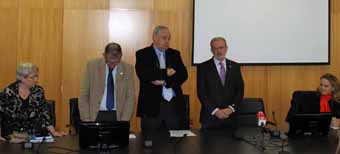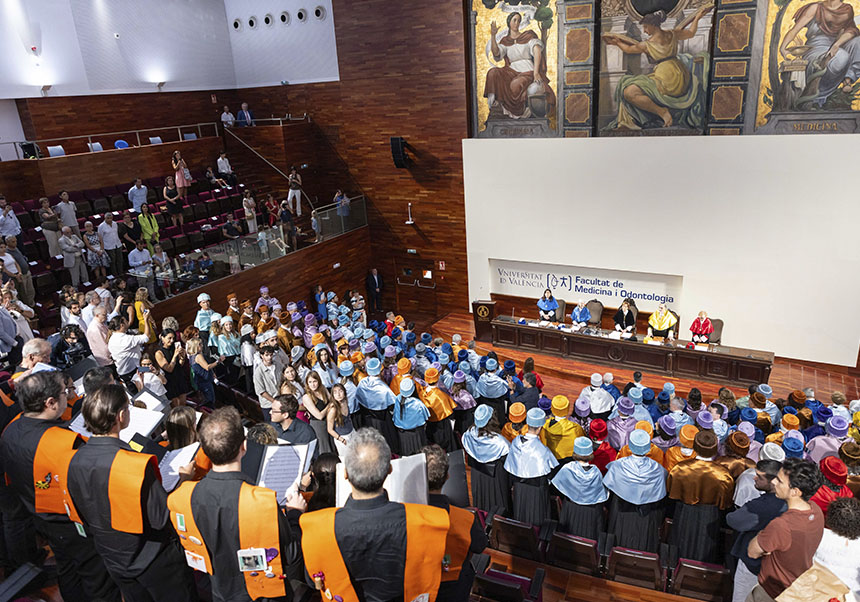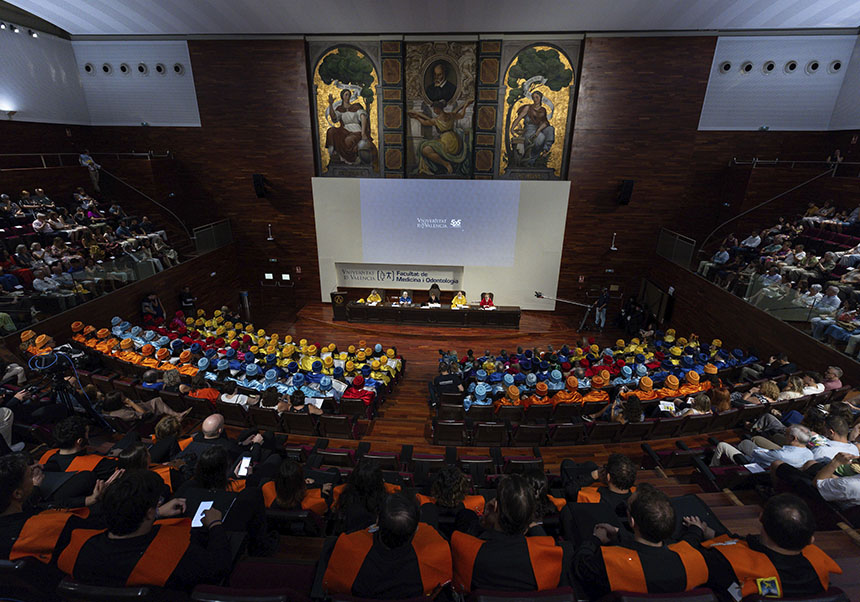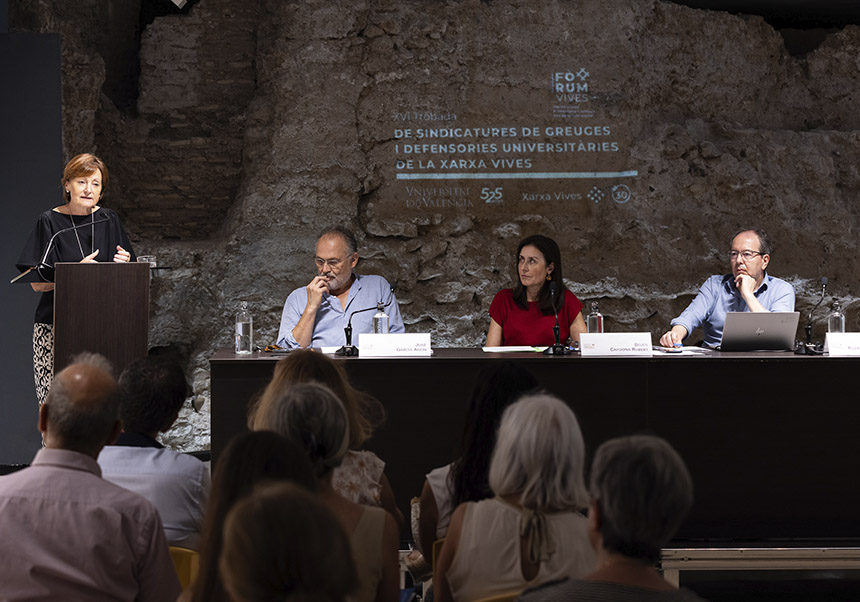
The principal of the University of Valencia, Esteban Morcillo, presented this Tuesday the results of the Project “Malaria in Africa with Technology with the Inesfly polymer microencapsulation”, coordinated by Professor Santiago Mas Coma, researcher of the Parasitology Unit of the Faculty of Pharmacy of the University of Valencia. The project research was conducted by the research team of the Parasitology Unit of the Faculty of Pharmacy of the University of Valencia.
For Esteban Morcillo, “any effort, any initiative, any idea that serves to face the fight against malaria, which is the greatest challenge of medicine, will be welcomed by the University of Valencia”. The principal made these statements before Santiago Mas Coma, full university professor of Cellular Biology and Parasitology, explained both the characteristics of this disease as the one produced by the mosquito and advances the results of the research made through the project “Una nova eina de lluita contra la malaria”. This project gives really encouraging results in the struggle against a disease that should be eradicated and that, on the other hand, causes half of the deaths in the world”, said Professor Mas Coma.
The collaboration between the University of Valencia and the Doctor Pilar Mateo has set up a project “totally encouraging, the results are exceptionally good”. This is the insecticide painting Inesfly 5A IGR which contains two organophosphates (OP), clorpyrifos and diazinon, and a growth regulator (IGR), the pyriproxifen. Inesfly is a water-soluble paint that can be applied to any other painting walls and other surfaces. This is a new product result of a polymer microencapsulation which allows to incorporate different active ingredients, such as the insecticides and regulators, and that provides a gradual and slow release of these assets, which provides a high residual power and offers, thanks to this microencapsulation which prevents the interaction of these active ingredients among them, for the first time the possibility of combining OP and IGR, with the enormous advantage which that represents in working the IGR preventing the appearance of resistance.
The product is currently in Phase III, the last level to get the approval of the World Health Organisation (WHO) and the permission for the open use of an insecticide product in the struggle against any infectious disease. Phases I and III were conducted in sub-Saharan Africa due to its high mortality in children under 5 years-old, and the results are “exceptional. The response was unexpectedly good and many possibilities of those initially expected were opened”, said the professor. Phase I includes the evaluation of its action on the insects in the laboratory, Phase II corresponds to the evaluation of its effectiveness on insects in endemic area, and Phase III refers to the assessment of the epidemiological and social impact of the disease in humans in endemic area. The evaluation project of the Inesfly painting have been made by the members of the Parasitology Unit of Valencia at the Centre de Reserche Entomologique of Cotonou (CREC), under the administrative coordination of the Reserche pour le Developpement French Institute (IRD), as well as the laboratory of the Unit in Valencia. “In Phase I of Evaluation in Laboratory it was determined that the painting induced a mortality of the 93-100% of mosquitoes, especially those resistant to the OP, after 1 complete year since the application of painting. It was verified that productiveness, fertility and emergence of the adult stages of mosquitoes were reduced especially in application for the lowest doses, up to the 9 months post-implementation. Phase II of Evaluation in Endemic area was conducted for one year in 6 houses especially built for the test in high endemic area in Benin. At the 6 months, the mortality rates in mosquitoes inside the houses were in the 90-100% in resistant mosquitoes populations. At 9 month, the mortality rate was 90-93% in Anopheles gambiae and Culex quinquesfaciatus.
Malaria is the most important infectious disease of mankind. It is caused by 4 species of microscopic protozoan blood parasites of the genus Plasmodium: Plasmodium vivax, Plasmodium ovale, Plasmodium falciparum and Plasmodium malariae. Of these, Plasmodium falciparum is the worst one due to the high mortality it causes, known as the “biggest killer of mankind”. Malaria is distributed to all tropical and subtropical areas of the globe, plunging in many temperate countries. “It is a disease without removing or keeping it at bay is not considered possible the normal development of human civilization. This is how malaria is always one the most important scourges in poor and developing countries. Africa is the most affected continent, where Anopheles gambiae mosquito is the most important vector”, said Mas Coma, honoris causa doctor by the University of Cluj-Napoca, Romania from the Faculty of Pharmacy.
The expert explained in front of an audience of scientists and researchers, that the fight against Malaria and its control are based on actions at a human level – development of medicines-. And in actions against the vector-insecticides mosquitoes, mosquito nets, etc. However, “in recent years there is no new promising drug and Plasmodiums can’t stop increasing the emergence of resistance to drugs we have. Moreover, the availability of a potential vaccine is not glimpsed for an immediate future, given the enormous complexity of precise genetic engineering, and the Anopheles have developed resistance to insecticides”.
Doctor Pilar Mateo has also been “optimistic in the development of this technology that not only manages to get rid of the mosquito in the short term, but at long term has a regulatory effect on the growth of the insect which prevents mutations to be transmitted from generation to generation”.
To Pilar Mateo, the role of the University of Valencia has made possible that “a technology as Inesfly gets where it is needed, to poverty”.
The principal has been accompanied by Olga Gil, vice-principal of international relation, Pedro Carrasco, vice-principal for research and science policy.

 para rectorado.jpg)

















